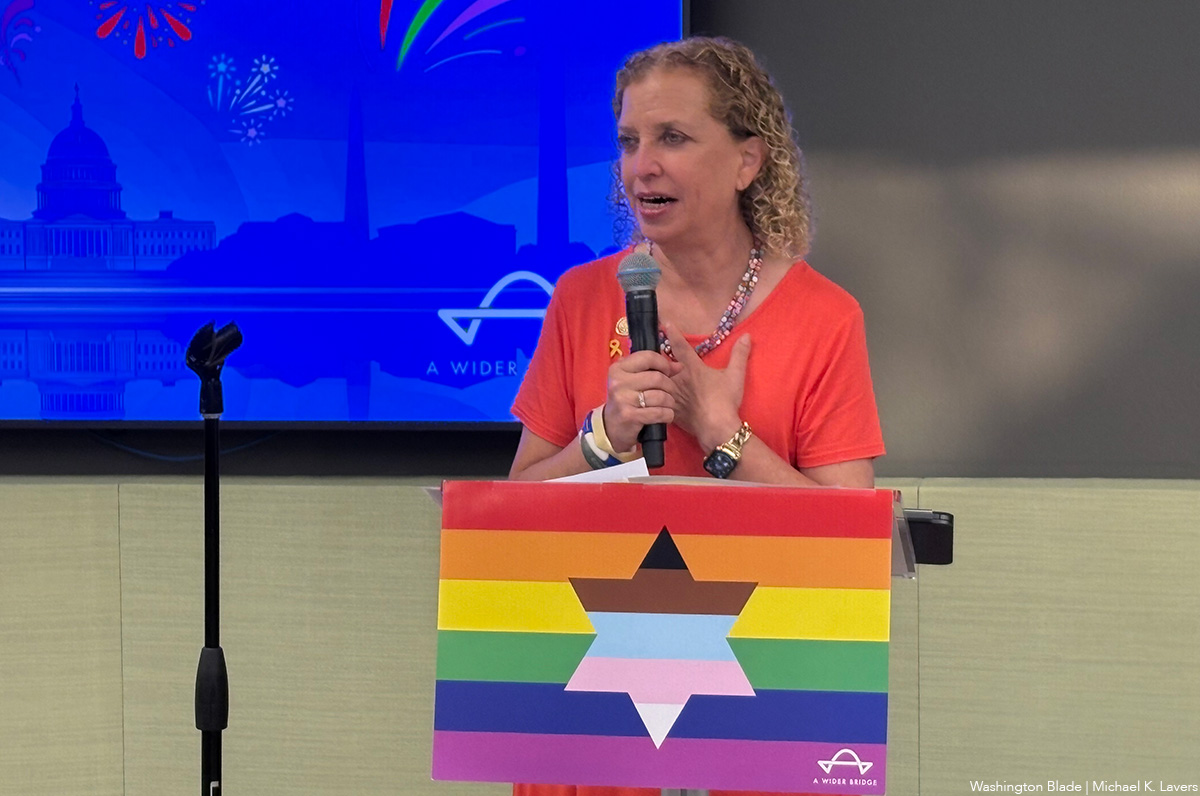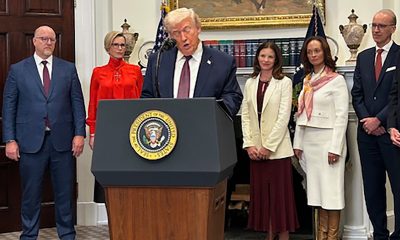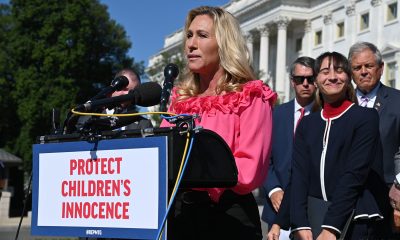National
HIV groups praise Obama for 2013 budget request
Domestic programs see increase, but research and int’l efforts cut

President Obama’s budget request for the upcoming fiscal year has won praise for including an increase in funds for domestic HIV treatment programs, although concerns persist about flat-funding for research programs and reductions in the chief program aimed at fighting the global AIDS epidemic.
The White House unveiled on Monday the president’s $3.8 trillion proposal to fund the U.S. government for fiscal year 2013, which includes funds for federally funded HIV/AIDS programs. The proposal was sent to Congress for lawmakers to act on and amend before passing into law.
Advocates for HIV/AIDS programs were largely happy with the recommendations made by the president on funding levels, which the White House says increases HIV/AIDS funding by $800 million, particularly with the Ryan White AIDS Drugs Assistance Programs, which provides grants to states for HIV/AIDS support services.
Carl Schmid, deputy executive director of the AIDS Institute, said the budget demonstrates Obama’s “strong commitment” to fight HIV by increasing funds “for prevention and lifesaving care and treatment for those who cannot afford it in the United States.”
“President Obama recognizes the importance of the federal government’s role in addressing infectious diseases, such as HIV, and the need to provide care and treatment to people with HIV/AIDS to keep them healthy and reduce new infections,” Schmid said. “We now urge Congress to show the same level of support as it considers federal spending priorities for the upcoming year.”
Under the budget, funding for the Ryan White AIDS Drug Assistance Program would increase by $102 million over the FY-12 levels that Congress appropriated for a total of $1 billion. Additionally, the president also proposes an increase of $20 million for Part C of the Ryan White HIV/AIDS Program to fund primary care for more than 550,000 people who have HIV/AIDS.
The increase will likely be welcome to news to individuals on wait lists for these programs. According to the National Alliance of State and Territorial AIDS Directors, 4,118 people are on ADAP waiting lists in 12 states and more than 445 people in six states have been disenrolled from the program due to budget constraints and growing enrollment.
Brian Hujdich, executive director of HealthHIV, also commended the president for increasing domestic HIV/AIDS funding, which he said is necessary until the government fully implements the health care reform law signed in 2009.
“The president has clearly identified HIV as a priority in 2013 by increasing funding for HIV care and treatment to those in the U.S. who cannot afford it, expanding access to life-saving HIV medication for the uninsured and underinsured, and increasing HIV prevention funding,” Hujdich said.
On World AIDS Day in December, President Obama announced an additional $35 million for the ADAP program and $15 million more for Part C of the Ryan White program. The proposed budget continues funds for those programs into FY-13 and increases it.
But funding for Ryan White hasn’t increased across the board. Obama proposes a decrease of $8 million to Part D of the Ryan White Program, which funds programs aimed at youth, women and families.
Other domestic HIV/AIDS programs are also seeing continued funds. The proposal requests $330 million for the Department of Housing & Urban Development’s Housing Opportunities for Persons with AIDS (HOPWA) program, which addresses housing needs for people with HIV/AIDS. The funding level this programs has been reduced by $2 million.
The president proposes an increase of HIV funding at the Centers for Disease Control and Prevention (CDC) by $40 million. These funds are expected to help CDC focus on communities most impacted by HIV, including blacks and gay men, by increasing testing programs and linking people to care.
Obama also restores a $10 million cut to HIV Adolescent and School Health as young people continue to account for new HIV infections. Congress cut that program in FY-12 by 25 percent of its budget.
Despite these funds, advocates are also concerned about flat-level funding for research programs that develop new ways to combat HIV/AIDS. The National Institutes for Health, the nation’s medical research agency, was allocated $31 billion in the president’s budget proposal —the same overall level as FY-12.
With regard to specific HIV/AIDS initiatives at NIH, the budget proposes $3.1 billion for intramural and extramural HIV/AIDS-related research. Funding for HIV/AIDS research was about $3.2 billion in FY-12.
Michael Cole-Schwartz, spokesperson for the Human Rights Campaign, expressed concern about funding for these research programs while generally supporting the level of HIV/AIDS funding in the budget.
“Given the constraints imposed by last year’s budget agreement, we are very happy to see some significant increases in key areas, including for the AIDS Drug Assistance Programs and early intervention in vulnerable populations,” Cole-Schwartz said. “However, we are concerned by flat funding and cuts in other areas, particularly at the National Institutes of Health, where ongoing research on HIV/AIDS is critical to the goal of ending the epidemic.”
Spencer Lieb, the AIDS Institute’s HIV/AIDS research coordinator, said the flat-level funding for NIH is peculiar given the president’s past support for this program.
“This is surprising given the recognition President Obama has given to the recent monumental advances in biomedical prevention research conducted by the NIH and the need for continued prevention research, including on vaccines and new drug therapies,” Lieb said.
Additionally, the budget makes cuts to efforts to combat HIV/AIDS programs overseas. Obama’s proposal cuts more than a half billion dollars, or almost 13 percent, from the President’s Emergency Plan for AIDS Relief (PEPFAR), which was established by President George W. Bush to provide anti-retroviral treatment to people with AIDS overseas.
Judith Aberg, chair of the HIV Medicine Association, said in a statement funding for PEPFAR in Obama’s request “falls short” of support needed “to put us on course to end AIDS globally.”
“The president is not providing the resources necessary to fulfill his commitment to putting 6 million on HIV treatment under the program or to scale up male circumcision or prevention of vertical transmission programs,” Aberg said. “Now is not the time to retreat on our investment in either of these lifesaving programs.”
Shin Inouye, a White House spokesperson, justified the reductions in PEPFAR by saying the program is “a real life success story of doing more with less” because it continues efficiency while lowering costs.
“The most important metric for PEPFAR is lives saved, not dollars spent, and through smart investments we are delivering results,” Inouye said.
According to the White House, the necessary funds for PEPFAR are lower because of generic drugs, the ability to ship commodities more cheaply in addition to task-shfiting to nurses and community health workers. Inouye said the cost to the United States per-patient of providing treatment for AIDS patients has fallen by over 50 percent since 2008.

A Wider Bridge on Friday announced it will shut down at the end of the month.
The group that “mobilizes the LGBTQ community to fight antisemitism and support Israel and its LGBTQ community” in a letter to supporters said financial challenges prompted the decision.
“After 15 years of building bridges between LGBTQ communities in North America and Israel, A Wider Bridge has made the difficult decision to wind down operations as of Dec. 31, 2025,” it reads.
“This decision comes after challenging financial realities despite our best efforts to secure sustainable funding. We deeply appreciate our supporters and partners who made this work possible.”
Arthur Slepian founded A Wider Bridge in 2010.
The organization in 2016 organized a reception at the National LGBTQ Task Force’s Creating Change Conference in Chicago that was to have featured to Israeli activists. More than 200 people who protested against A Wider Bridge forced the event’s cancellation.
A Wider Bridge in 2024 urged the Capital Pride Alliance and other Pride organizers to ensure Jewish people can safely participate in their events in response to an increase in antisemitic attacks after Hamas militants attacked Israel on Oct. 7, 2023.
The Jewish Telegraphic Agency reported authorities in Vermont late last year charged Ethan Felson, who was A Wider Bridge’s then-executive director, with lewd and lascivious conduct after alleged sexual misconduct against a museum employee. Rabbi Denise Eger succeeded Felson as A Wider Bridge’s interim executive director.
A Wider Bridge in June honored U.S. Rep. Debbie Wasserman Schultz (D-Fla.) at its Pride event that took place at the Capital Jewish Museum in D.C. The event took place 15 days after a gunman killed two Israeli Embassy employees — Yaron Lischinsky and Sarah Milgrim — as they were leaving an event at the museum.
“Though we are winding down, this is not a time to back down. We recognize the deep importance of our mission and work amid attacks on Jewish people and LGBTQ people – and LGBTQ Jews at the intersection,” said A Wider Bridge in its letter. “Our board members remain committed to showing up in their individual capacities to represent queer Jews across diverse spaces — and we know our partners and supporters will continue to do the same.”
Editor’s note: Washington Blade International News Editor Michael K. Lavers traveled to Israel and Palestine with A Wider Bridge in 2016.
The White House
‘Trump Rx’ plan includes sharp cuts to HIV drug prices
President made announcement on Friday

President Donald Trump met with leaders from some of the world’s largest pharmaceutical companies at the White House on Friday to announce his new “Trump Rx” plan and outline efforts to reduce medication costs for Americans.
During the roughly 47-minute meeting in the Roosevelt Room, Trump detailed his administration’s efforts to cut prescription drug prices and make medications more affordable for U.S. patients.
“Starting next year, American drug prices will come down fast, furious, and will soon be among the lowest in the developed world,” Trump said during the meeting. “For decades, Americans have been forced to pay the highest prices in the world for prescription drugs by far … We will get the lowest price of anyone in the world.”
Trump signed an executive order in May directing his administration “to do everything in its power to slash prescription drug prices for Americans while getting other countries to pay more.”
“This represents the greatest victory for patient affordability in the history of American health care, by far, and every single American will benefit,” he added.
Several pharmaceutical executives stood behind the president during the announcement, including Sanofi CEO Paul Hudson, Novartis CEO Vas Narasimhan, Genentech CEO Ashley Magargee, Boehringer Ingelheim (USA) CEO Jean-Michel Boers, Gilead Sciences CEO Dan O’Day, Bristol Myers Squibb General Counsel Cari Gallman, GSK CEO Emma Walmsley, Merck CEO Robert Davis, and Amgen Executive Vice President Peter Griffith.
Also in attendance were Health and Human Services Secretary Robert F. Kennedy Jr., Commerce Secretary Howard Lutnick, Centers for Medicare and Medicaid Services Administrator Mehmet Oz, and Food and Drug Administration Commissioner Marty Makary.
Under the Trump Rx plan, the administration outlined a series of proposed drug price changes across multiple companies and therapeutic areas. Among them were reductions for Amgen’s cholesterol-lowering drug repatha from $573 to $239; Bristol Myers Squibb’s HIV medication reyataz from $1,449 to $217; Boehringer Ingelheim’s type 2 diabetes medication jentadueto from $525 to $55; Genentech’s flu medication xofluza from $168 to $50; and Gilead Sciences’ hepatitis C medication epclusa from $24,920 to $2,425.
Additional reductions included several GSK inhalers — such as the asthma inhaler advair diskus 500/50, from $265 to $89 — Merck’s diabetes medication januvia from $330 to $100, Novartis’ multiple sclerosis medication mayzent from $9,987 to $1,137, and Sanofi’s blood thinner plavix from $756 to $16. Sanofi insulin products would also be capped at $35 per month’s supply.
These prices, however, would only be available to patients who purchase medications directly through TrumpRx. According to the program’s website, TrumpRx “connects patients directly with the best prices, increasing transparency, and cutting out costly third-party markups.”
Kennedy spoke after Trump, thanking the president for efforts to lower pharmaceutical costs in the U.S., where evidence has shown that drug prices — including both brand-name and generic medications — are nearly 2.78 times higher than prices in comparable countries. According to the Pharmaceutical Research and Manufacturers of America, roughly half of every dollar spent on brand-name drugs goes to entities that play no role in their research, development, or manufacturing.
“This is affordability in action,” Kennedy said. “We are reversing that trend and making sure that Americans can afford to get the life-saving solutions.”
Gilead CEO Dan O’Day also spoke about how the restructuring of drug costs under TrumpRx, combined with emerging technologies, could help reduce HIV transmission — a virus that, if untreated, can progress to AIDS. The LGBTQ community remains disproportionately affected by HIV.
“Thank you, Mr. President — you and the administration,” O’Day said. “I think this objective of achieving the commitment to affordability and future innovation is extraordinary … We just recently launched a new medicine that’s only given twice a year to prevent HIV, and we’re working with Secretary Kennedy and his entire team, as well as the State Department, as a part of your strategy to support ending the epidemic during your term.
“I’ve never been more optimistic about the innovation that exists across these companies and the impact this could have on America’s health and economy,” he added.
Trump interjected, asking, “And that’s working well with HIV?”
“Yes,” O’Day replied.
“It’s a big event,” Trump said.
“It literally prevents HIV almost 100 percent given twice a year,” O’Day responded.
A similar anti-HIV medication is currently prescribed more than injectable form mentioned by O’Day. PrEP, is a medication regimen proven to significantly reduce HIV infection rates for people at high risk. Without insurance, brand-name Truvada can cost roughly $2,000 per month, while a generic version costs about $60 per month.
Even when medication prices are reduced, PrEP access carries additional costs, including clinic and laboratory fees, office visits, required HIV and sexually transmitted infection testing, adherence services and counseling, and outreach to potentially eligible patients and providers.
According to a 2022 study, the annual total cost per person for PrEP — including medication and required clinical and laboratory monitoring — is approximately $12,000 to $13,000 per year.
The TrumpRx federal platform website is now live at TrumpRx.gov, but the program is not slated to begin offering reduced drug prices until January.
The White House
EXCLUSIVE: Democracy Forward files FOIA lawsuit after HHS deadnames Rachel Levine
Trans former assistant health secretary’s name changed on official portrait

Democracy Forward, a national legal organization that works to advance democracy and social progress through litigation, policy and public education, and regulatory engagement, filed a lawsuit Friday in federal court seeking to compel the U.S. Department of Health and Human Services to release information related to the alteration of former Assistant Secretary for Health Adm. Rachel Levine’s official portrait caption.
The lawsuit comes in response to the slow pace of HHS’s handling of multiple Freedom of Information Act requests — requests that federal law requires agencies to respond to within 20 working days. While responses can take longer due to backlogs, high request volumes, or the need for extensive searches or consultations, Democracy Forward says HHS has failed to provide any substantive response.
Democracy Forward’s four unanswered FOIA requests, and the subsequent lawsuit against HHS, come days after someone in the Trump-Vance administration changed Levine’s official portrait in the Hubert H. Humphrey Building to display her deadname — the name she used before transitioning and has not used since 2011.
According to Democracy Forward, HHS “refused to release any records related to its morally wrong and offensive effort to alter former Assistant Secretary for Health Admiral Rachel Levine’s official portrait caption.” Levine was the highest-ranking openly transgender government official in U.S. history and served as assistant secretary for health and as an admiral in the U.S. Public Health Service Commissioned Corps from 2021 to 2025.
Democracy Forward President Skye Perryman spoke about the need to hold the Trump-Vance administration accountable for every official action, especially those that harm some of the most targeted Americans, including trans people.
“The question every American should be asking remains: what is the Trump-Vance administration hiding? For an administration that touts its anti-transgender animus and behavior so publicly, its stonewalling and silence when it comes to the people’s right to see public records about who was behind this decision is deafening,” Perryman said.
“The government’s obligation of transparency doesn’t disappear because the information sought relates to a trailblazing former federal official who is transgender. It’s not complicated — the public is entitled to know who is making decisions — especially decisions that seek to alter facts and reality, erase the identity of a person, and affect the nation’s commitment to civil rights and human dignity.”
“HHS’s refusal to respond to these lawful requests raises more serious concerns about transparency and accountability,” Perryman added. “The public has every right to demand answers — to know who is behind this hateful act — and we are going to court to get them.”
The lawsuit also raises questions about whether the alteration violated federal accuracy and privacy requirements governing Levine’s name, and whether the agency improperly classified the change as an “excepted activity” during a lapse in appropriations. By failing to make any determination or produce any records, Democracy Forward argues, HHS has violated its obligations under federal law.
The case, Democracy Forward Foundation v. U.S. Department of Health and Human Services, was filed in the U.S. District Court for the District of Columbia. The legal team includes Anisha Hindocha, Daniel McGrath, and Robin Thurston.
The Washington Blade reached out to HHS, but has not received any comment.
The lawsuit and four FOIA requests are below:



















